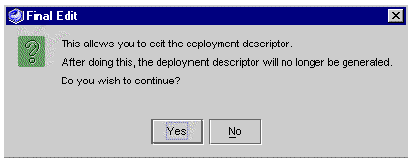| A P P E N D I X B |
|
Deployment Descriptors |
When you generate runtime classes for your web service, a web module and EJB module deployment descriptor are also generated. When you assemble your web service J2EE application, these deployment descriptors are included in the application. The deployment descriptors are XML files used to configure runtime properties of the application. The J2EE specification defines the format of these descriptors.
You can view your web service's deployment descriptors in the Source Editor at any time during development. You can also edit the deployment descriptors. This appendix describes the procedures for viewing and editing deployment descriptors.
This section lists the fields in the IDE that are normally propagated to your web service's deployment descriptors. If you edit one of these deployment descriptors and afterward change the value of any field that is normally propagated to that deployment descriptor, you must edit the deployment descriptor manually and insert the new value.
The Resolve Objects dialog box contains several fields that are propagated to the EJB module deployment descriptor. The corresponding elements in the deployment descriptor are all subelements of an ejb-ref element. The following table lists those fields.
Your web service's property sheet contains a property named Environment Entries. The fields in this property are propagated to the EJB module deployment descriptor. The corresponding elements in the deployment descriptor are all subelements of an env-entry element. The following table lists those fields.
To view the web module or EJB module deployment descriptor:
 Right-click your web service node and choose one of these menu items:
Right-click your web service node and choose one of these menu items:
The deployment descriptor is displayed in the Source Editor in read-only mode.
To edit the web module or EJB module deployment descriptor:
1. Right-click your web service node and choose one of these menu items:
The Final Edit dialog box is displayed, as illustrated in FIGURE B-1. The dialog box reminds you that after editing the deployment descriptor, the descriptor will no longer be regenerated by the IDE when you regenerate the runtime classes of your web service.

2. If you are sure you will not need to regenerate the deployment descriptor, click Yes. Otherwise click No.
The deployment descriptor is displayed in the Source Editor in edit mode. The deployment descriptor will not be regenerated if you regenerate runtime classes for your web service.
Copyright © 2003, Sun Microsystems, Inc. All rights reserved.